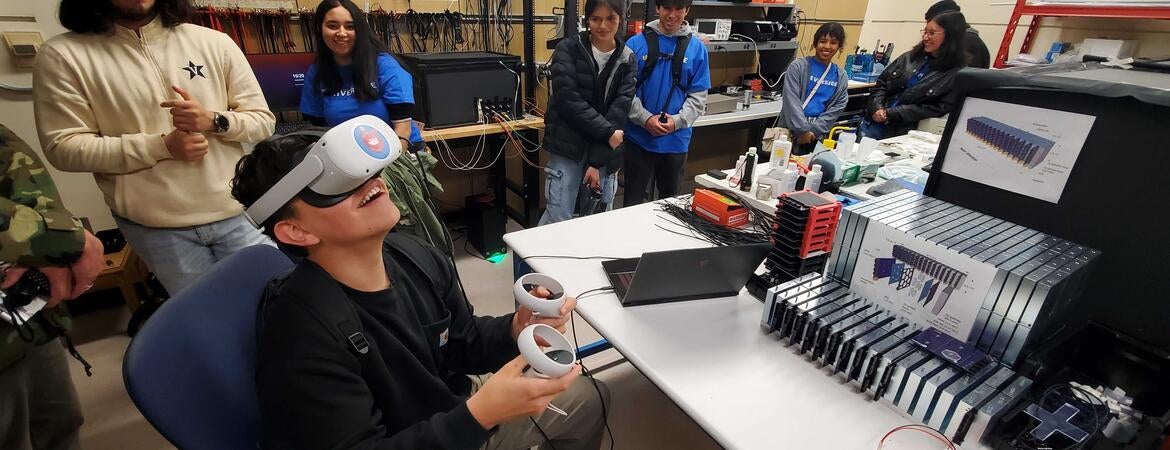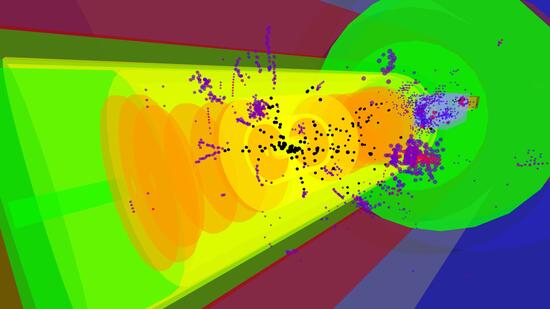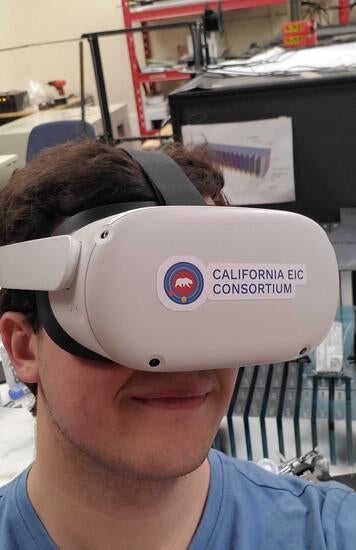
Virtual reality, or VR, is not just for fun-filled video games and other visual entertainment. This technology, involving a computer-generated environment with objects that seem real, has found many scientific and educational applications as well.
Sean Preins, a doctoral student in the Department of Physics and Astronomy at the University of California, Riverside, has created a VR application called VIRTUE, for “Virtual Interactive Reality Toolkit for Understanding the EIC,” that is a game changer in how particle and nuclear physics data can be seen.
Made publicly available on Christmas Day, VIRTUE can be used to visualize experiments and simulated data from the upcoming Electron-Ion Collider, or EIC, a planned major new nuclear physics research facility at Brookhaven National Lab in Upton, New York. EIC will explore mysteries of the “strong force” that binds the atomic nucleus together. Electrons and ions, sped up to almost the speed of light, will collide with one another in the EIC.
According to Miguel Arratia, an assistant professor of physics and astronomy at UCR who advises Preins, VR technology will enable a completely new way to explore particle and nuclear physics data in both space and time.
“I anticipate this tool will be immensely beneficial for researchers, aiding them in gaining intuition that can translate into insights during data analysis,” he said. “For instance, it could inspire the development of novel algorithms targeting specific signals or assist in a holistic exploration of intriguing events. This is the first time anyone has visualized EIC collisions. Before our work, nobody really knew what the events looked like.”
Videos made with VIRTUE have already been used by Brookhaven National Laboratory to draw the public’s attention to the EIC. Meant to be an innovative outreach platform for a general audience, VIRTUE is also an educational tool for students and senior scientists alike. It will be released on Steam, a popular video game engine, for free.
In the following Q&A, Preins answers a few questions about VIRTUE:
Q. Does one need to wear special VR goggles to use the program? What would a user see?
This program is designed to work with the Oculus Quest 2 with Quest Link; however, a VR headset is not required. You will be able to download and run a desktop version of VIRTUE with all the same features as the VR version.
The program comes pre-installed with an X-ray and engineering model of the ePIC detector at the future EIC. It also comes with simulated data from electron-proton collisions in this detector, where each collision results in a spray of “hits,” or points, where the detector records a signal from a particle that passed through. In a sense, it shows you what a particle detector “sees” when a collision happens. It is the same data one would use for research too.
Q. What advantage does a VR program like VIRTUE offer to scientists?
Using VR to visualize particle physics data allows us to get a sense of scale with these experiments that just can't be replicated on a small screen, and it allows us to explore the complexity of the data in space and in time. Our brains excel at recognizing patterns and VR enhances this capability, allowing for a more immersive and intuitive understanding of data.
We have also used this program during many outreach events, and it has been a hit every time. VR is an excellent tool that engages young scientists with an immersive experience for a subject that is often difficult to visualize.
Q. Is VIRTUE easy to use?
Even if you don't have a VR headset, you will still be able to download and run this application on most modern Windows, macOS, and Linux machines. Running this program and viewing collisions is as simple as installing any other game on Steam. No programming knowledge is required.
This program will give users a deeper insight into how particle detectors collect data and shows a preview of the science that will be done at the EIC. This can be used to help teach what each layer of a particle detector is for, what kind of signal each type of particle creates in the detector, and how we can reconstruct the physics of what happened during the collision from the raw data the detector records.
VIRTUE allows for a high degree of customizability. The data can be easily updated with new simulations — or even real data once the EIC is built.
Q. What got you interested in launching VIRTUE?
A large motivation for this program is to make the science of collider physics more accessible. Tools like VIRTUE allow us to educate students on what goes on inside a particle detector, and how we can extract useful information from this data to study some of the deepest laws of nature. I have already been using this program to help introduce the methods used in collider and detector physics to new undergraduate researchers in our group.





